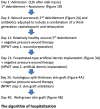Successful salvage and reconstruction of a finger threatened by Vibrio vulnificus necrotising fasciitis using fenestrated-type artificial dermis and three steps of topical negative pressure wound therapy
- PMID: 28052529
- PMCID: PMC7949603
- DOI: 10.1111/iwj.12711
Successful salvage and reconstruction of a finger threatened by Vibrio vulnificus necrotising fasciitis using fenestrated-type artificial dermis and three steps of topical negative pressure wound therapy
Abstract
Vibrio vulnificus can cause severe skin and soft tissue infection (SSTI). The pathogen is an opportunistic marine bacterium that is likely to infect patients with chronic liver disease, patients in an immunocompromised state, and those in end-stage renal disease. V. vulnificus gains entry through soft tissues by direct penetration of a wound by infected marine organisms, such as raw oysters, shellfish and other seafood, or by exposing a wound to contaminated water. Despite its ease of entry, V. vulnificus necrotising fasciitis with compartment syndrome has rarely been described. We report a case of an elderly patient with end-stage renal disease undergoing haemodialysis, who developed necrotising fasciitis following infection by V. vulnificus through a puncture injury while cleaning fish. A successful salvage and reconstruction surgery was performed using fenestrated-type artificial dermis followed by negative pressure wound therapy. This case presents a reasonable treatment option for threatening V. vulnificus necrotising fasciitis with compartment syndrome.
Keywords: Artificial dermis; Compartment syndrome; NPWT; Necrotising fasciitis; Vibrio vulnificus.
© 2017 Medicalhelplines.com Inc and John Wiley & Sons Ltd.
Figures





Similar articles
-
Necrotising fasciitis with Vibrio vulnificus: a limb threatening dermatologic complication following exposure to marine life.BMJ Case Rep. 2010 May 6;2010:bcr11.2009.2478. doi: 10.1136/bcr.11.2009.2478. BMJ Case Rep. 2010. PMID: 22736735 Free PMC article.
-
Finger Necrotizing Fasciitis and Septicemia Caused by Vibrio vulnificus.Surg Infect (Larchmt). 2024 May;25(4):329-331. doi: 10.1089/sur.2023.284. Epub 2024 Apr 12. Surg Infect (Larchmt). 2024. PMID: 38608243
-
Necrotizing soft-tissue infections and primary sepsis caused by Vibrio vulnificus and Vibrio cholerae non-O1.J Trauma. 2009 Mar;66(3):899-905. doi: 10.1097/TA.0b013e31816a9ed3. J Trauma. 2009. PMID: 19276771
-
Vibrio vulnificus: Review of Mild to Life-threatening Skin Infections.Cutis. 2021 Feb;107(2):E12-E17. doi: 10.12788/cutis.0183. Cutis. 2021. PMID: 33891847 Review.
-
Epidemiology, pathogenetic mechanism, clinical characteristics, and treatment of Vibrio vulnificus infection: a case report and literature review.Eur J Clin Microbiol Infect Dis. 2019 Nov;38(11):1999-2004. doi: 10.1007/s10096-019-03629-5. Epub 2019 Jul 19. Eur J Clin Microbiol Infect Dis. 2019. PMID: 31325061 Review.
Cited by
-
Combined with the first dorsal (plantar) metatarsal artery pedicle free bilobed flap with a cell scaffold for the repair of a mid-distal adjacent finger defect: a retrospective study.J Orthop Surg Res. 2024 Apr 27;19(1):267. doi: 10.1186/s13018-024-04656-5. J Orthop Surg Res. 2024. PMID: 38678260 Free PMC article.
-
Negative Pressure Wound Therapy for Gas Gangrene of the Fingertip with Prolonged Infection.Plast Reconstr Surg Glob Open. 2024 May 1;12(5):e5782. doi: 10.1097/GOX.0000000000005782. eCollection 2024 May. Plast Reconstr Surg Glob Open. 2024. PMID: 38699285 Free PMC article.
References
-
- Lim PL. Wound infections in tsunami survivors: a commentary. Ann Acad Med Singapore 2005;34:582–5. - PubMed
-
- Centers for Disease Control and Prevention (CDC) . Vibrio illnesses after Hurricane Katrina—multiple states, August–September, 2005. MMWR Morb Mortal Wkly Rep 2005;54:928–31. - PubMed
-
- Huang KC, Hsieh PH, Huang KC, Tsai YH. Vibrio necrotizing soft‐tissue infection of the upper extremity: factors predictive of amputation and death. J Infect 2008;57:290–7. - PubMed
-
- Wong CH, Khin LW, Heng KS, Tan KC, Low CO. The LRINEC (laboratory risk indicator for necrotizing fasciitis) score: a tool for distinguishing necrotizing fasciitis from other soft tissue infections. Crit Care Med 2004;32:1535. - PubMed
-
- Wong CH, Wang YS. The diagnosis of necrotizing fasciitis. Curr Opin Infect Dis 2005;18:101. - PubMed
Publication types
MeSH terms
LinkOut - more resources
Full Text Sources
Other Literature Sources

